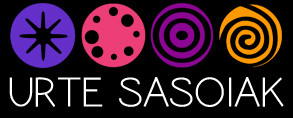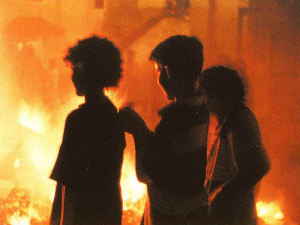Saint John’s Eve festival
Our ancestors scheduled their festivities around Nature’s cycle. They ritualized the seasons of the year and, particularly, the winter and summer solstices (the former on 21 December and the latter on 21 June). Saint John’s Day, the longer day of the year, is associated to the summer solstice and the arrival of the summer or the Sun’s season. It was believed that on that day the Sun rose dancing up in the sky, and people would climb mountains to watch it make its appearance.
Echoes of numerous ancient beliefs, customs and rites are related to Saint John and his memorial. Fire, water and plants are the most relevant and best-known elements of the festival.
Saint John’s Eve bonfire
The bonfire is the most representative element of this festival. The Sun provides us with light and warmth, and so does fire; and both merge in the events of this day. In the evening of Saint John’s Eve, bonfires were lit in the village square, farmhouses, fields and crossroads. The custom continues unaltered. People in the past used to meet around the bonfire and jump over it saying: “San Juan, San Juan berde, artoa eta garia gorde, txantxikuak eta zapoak erre. Biba San Juan berde!” (Saint John, green Saint John, look after the maize and the wheat, burn the midwife and the common toads. Hurray for green Saint John!) or this other version: “San Juan Bautista, onak barnera, gaitze kanpora, bakia eta osasuna komeni bada. Sarna fuera!” (Saint John the Baptist, keep goodness and get rid of badness if peace and health are needed. Keep mange away!).
Fire was believed to have the power to protect humans, animals and fields: it keeps humans safe from disease, especially skin infections; farm animals were made to walk on the ashes left from the bonfire to guard them from all kind of affection; people would walk across the cultivated fields holding a lit bundle and wishing that those flames would repel thieves, witchcraft and harmful creatures.
Water
Water from seas, rivers, sources and even dew drops acquire new exceptional powers on this day. On Saint John’s Eve, water is magical. At midnight stones become bread and water turns into wine.
At sunrise it was customary across the length and breadth of Euskal Herria to take a walk on the morning dew, to stroll barefoot on grass, to cross the wheat fields naked or to clean one’s face, hands and feet in sources. Theses practices were thought to cure skin disease (scabies, mange, leprosy, etc.) and also to fend off these kind of infections. In Nafarroa the act of bathing oneself in a river or source at midnight on Saint John’s Eve or in the morning of Saint John’s Day was known as sanjuanada.
Besides, in Nafarroa sterile women would rub their abdomens against a stone after drinking water from a source on Saint John’s Eve at night in the hope that they would become pregnant by observing this rite.
Plants
On the eve of Saint John’s Day a bouquet of wild flowers, wheat and maize leaves, heads of garlic, apple tree branches and the like was arranged. The following day the bouquets were blessed at church during the main service, and on returning home, they were left to dry in the attic. In the event of lightning, a piece of the bouquet was burned in the fireplace. The unburned remains of the bunch were hurled on Saint John’s Eve bonfire.
On Saint John’s Day, before sunrise, ash tree or hawthorn branches were cut off in the woods and brought home to decorate doors and balconies and protect the house and household from storms and lightening. The branches were kept until they were finally burned on the following year’s bonfire. This custom is still preserved in numerous houses and farmhouses. In Nafarroa, on the contrary, they use sunflowers, which are representative of the Sun itself. This flower is a symbol of protection against witches and bad spirits, and is also used to dispel illness from livestock.
Apart from the plants, trees too constitute an important part of this summer festival. In many villages an unbranched ash or a poplar tree is placed in the middle of the square or in front of the church. The tree is chosen and taken, even without permission from its owner. The trunk is adorned with flowers and plants, and a puppet made of old pieces of fabric and straw, txotxongiloa, is attached to the top. In some places the trunk is burned, and in others, once the flowers are dried, it is simply removed.
Last but not least, and to finish with Saint John’s Day rituals, we shall mention the routine to cure hernias in young children. They mostly used the trunk of a common or a holm oak. Two men named Juan participated in the ritual. One of them held the child in his arms until the church bell stroke at midnight. On hearing the first stroke of the bell, he passed the child over to the second man between two branches or through the gap opened with the help of an axe saying “Juanek uzten zaitu” (Juan leaves you). The second man replied “Juanek hartzen zaitu” (Juan takes you) while he received the child. This procedure was repeated until the bells stopped ringing. Then the two branches were tied together or the hole in the tree filled; if the tree lived on, the child was cured, but if it died, the illness persevered.




